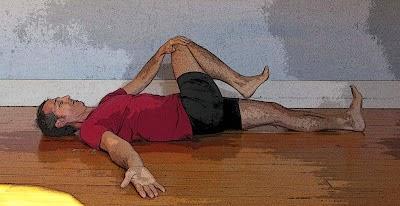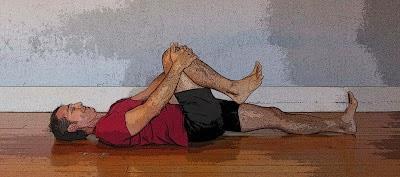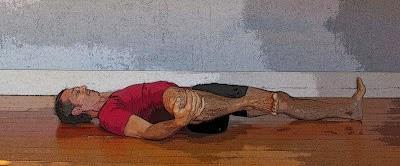
Pose to Avoid for People with Posterior Lateral Hip Replacement
A reader left this question on our post Featured Sequence: Dynamic Reclined Hip Stretches (Rerun).Q: What adaptation would you use for someone with a hip replacement?
A: To answer this question, we need to consider the type of hip replacement the yoga practitioner has had. Which type of replacement person has had going to affect their asana practice.
To review from our post on total hip replacements and yoga, the basic categories of total hip replacement are:
- posterior lateral approach
- anterior lateral approach
- anterior approach
- minimally invasive anterior approach or minimally invasive posterior approaches
In general, everyone who has a hip replacement should ask their surgeon what their post-operative physical limitations are and for how long. Make sure you learn how to safely get up and down from the floor so you don’t dislocate your new hip. And make sure that you learn the specific precautions associated with your category of hip replacement. The key is that you learn to identify what position your hip is in when you do your poses. Think of both legs when you do each side (don’t just focus on the surgical side).
In the more traditional posterior or posterior lateral approach there are limitations on hip flexion, adduction and internal rotation. That means that if you combine these three positions you are more apt to dislocate your prosthetic hip because the muscle support is weakened by the surgical procedure. Poses you might want to not do for approximately six months would be: Standing Forward Bend (Uttanasana), Eagle pose (Garudasana), Cow-Face pose (Gomukhasana), and Child’s pose (Balasana). Gentle backbends generally are okay for posterior/posterior lateral hips.
For anterior lateral hips the precautions will be very different. Typically hip extension and hip abduction will be affected and you don’t want to be aggressive in these combined movements. So start thinking about your backbends and standing poses. Remember that the position of the front and the back legs are very different in the standing poses. The front hip may be placed into positions of flexion and external rotation and abduction but the back hip may be in extension with external rotation.
For anterior hip replacement surgeries the doctor will typically tell you that you have no restrictions but that doesn’t mean you are going to jump back into your asana practice. The hip is going to be sore and painful because of the surgical trauma (though it is less in this procedure than some of the other ones I talked about because there is no actual muscle cutting in this procedure but the muscles are certainly stretched as they are moved for the surgery).
Now to Baxter's sequence, Dynamic Reclined Hip Stretches: To answer this question I combined hip surgeries into two categories; anterior and posterior approaches. That’s because functionally there isn't a whole lot of difference in precautions for each subcategories within the two main categories.
1. Deep Hip Flexion.

Flexion Greater Than 90 Degrees
All four poses in the sequence involve deep hip flexion. The reason hip flexion works for low back discomfort is that the ilium rotates posteriorly when the knee and hip are flexed, and, conversely, the lumbar spinal curve is reversed and the back flattens. This often feels good because those tight low back extensor muscles are stretched.However, with a hip replacement, flexion beyond 90 degrees often causes a "pinching" sensation in the groin region. If the hip replacement was an anterior approach there is no fear of dislocation but discomfort can certainly arise. However, with a posterior lateral approach, the position of deep hip flexion is not recommended due to dislocation risks. (Unfortunately there is no time when a hip replacement will not dislocate, but typically the high-risk time is 0-90 days post-
operatively).
As a modification, you could try using a chair. Place your top leg on the chair so your calf is resting on the chair seat, and your hip and knee are bent at 90/90. Lengthen your bottom leg underneath the chair seat. This makes the pose more passive and this gentler approach might be the safer way to go. (I don't like teaching my students to “deeper” into a pose using overpressure with their arms because I think this is a potential way to cause injury. I believe that for muscle release to occur, you should take the joint to its pain-free position and breathe while statically holding the pose.)
2. Hip and Knee Flexion with Abduction and External Rotation

3. Knee to Chest Moving Over the Midline.

Finally, the key concept is that regardless of the type of surgical approach, you need to learn to respect your hip and never push into pain. Posterior lateral hip replacements are more dislocation-prone than anterior hip replacement procedures but end-range overpressure will cause discomfort in anterior hip replacements. And, unfortunately, if the prosthesis is sized improperly, even trying to do the modifications I’ve recommended might still be uncomfortable. In that case, go back to your surgeon—or ask your student to go back to their surgeon—for some frank discussions on the specific dos and don'ts for their hip replacement.
—Shari
Subscribe to YOGA FOR HEALTHY AGING by Email ° Follow Yoga for Healthy Aging on Facebook

